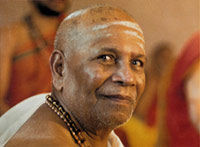
Sri K Pattabhi Jois is a leading exponent of Ashtanga Yoga
Ashtanga Yoga (sometimes spelled as Astanga) is a dynamic and vigorous practice that uses pranayama (breath control) techniques to flow from one asana (posture) to the next.
In recent times, Ashtanga Yoga has been popularized by renowned yoga master Sri K. Pattabhi Jois. To avoid the confusion with traditional Ashtanga Yoga, some people refer Pattabhi Jois’ system as Ashtanga Vinyasa Yoga or Power Yoga.
Regular practice of Ashtanga Yoga cleanses the body, stills the mind and enhances energy and fitness levels.
Vinsaya (Breadth-Synchronized Movement)
The Vinsaya is a style that makes Ashtanga Yoga different from other forms of Yoga. Vinsaya means the movement and breathing which is used effectively together in order to cleanse the body. Each movement done is accompanied by only one breath.
Pattabhi Jois describes vinyasa as a “yoga mala†(Mala means garland or rosary). This means that like a garland of flowers or rosary of prayers, vinyasa is a garland or rosary of yoga postures, threaded together through the flow of breathing.

Ujjayi breathing is the breathing technique used in the practice of Ashtanga Yoga. Breathing in is synchronized with the movements, in such a way that each movement is accompanied by breath.
Regular practice of Ashtanga Yoga will help you hold your pose longer and build your lung capacity. Sweat is an important part of the vinsaya. When you perform the asanas, your body produces heat and excretes toxins via perspiration. The aim is to cleanse and detoxify the body at all levels including organs, muscles, blood and nervous system.
Asanas
In Ashtanga Yoga, poses are used to develop physical strength and health of the body and can be grouped into the following:
Primary Series: Alignment and Detoxification
Intermediate Series: Opening and Cleansing of Energy Channels and Purification of Nervous System.
Advanced Series: Development of Grace and Strength
Proper practice of Ashtanga involves the application a yoga principle known as Tristhana which that symbolizes the union of the three elements of posture, breathing and dristi (the gazing point which helps your mind to focus). All these three should work altogether to perform a function.
In Malaysia, we have a wide variety of Ashtanga Yoga classes which include traditional Ashtanga, Power Yoga and led Ashtanga classes
Video of Interview with Pattabhi Jois
This video outlines some of Pattabhi Jois’ important philosophies in the practice of Ashtanga Yoga:
“Yoga is not just physical, it is internal cleansing”
“Yoga is 5% theory and 95% practice”
Please allow several minutes for video to download fully.
Ashtanga Yoga teacher David Williams (from Hawaii USA) puts it this way:
“Before you’ve practiced, the theory is useless.
After you’ve practiced, the theory is obvious.”